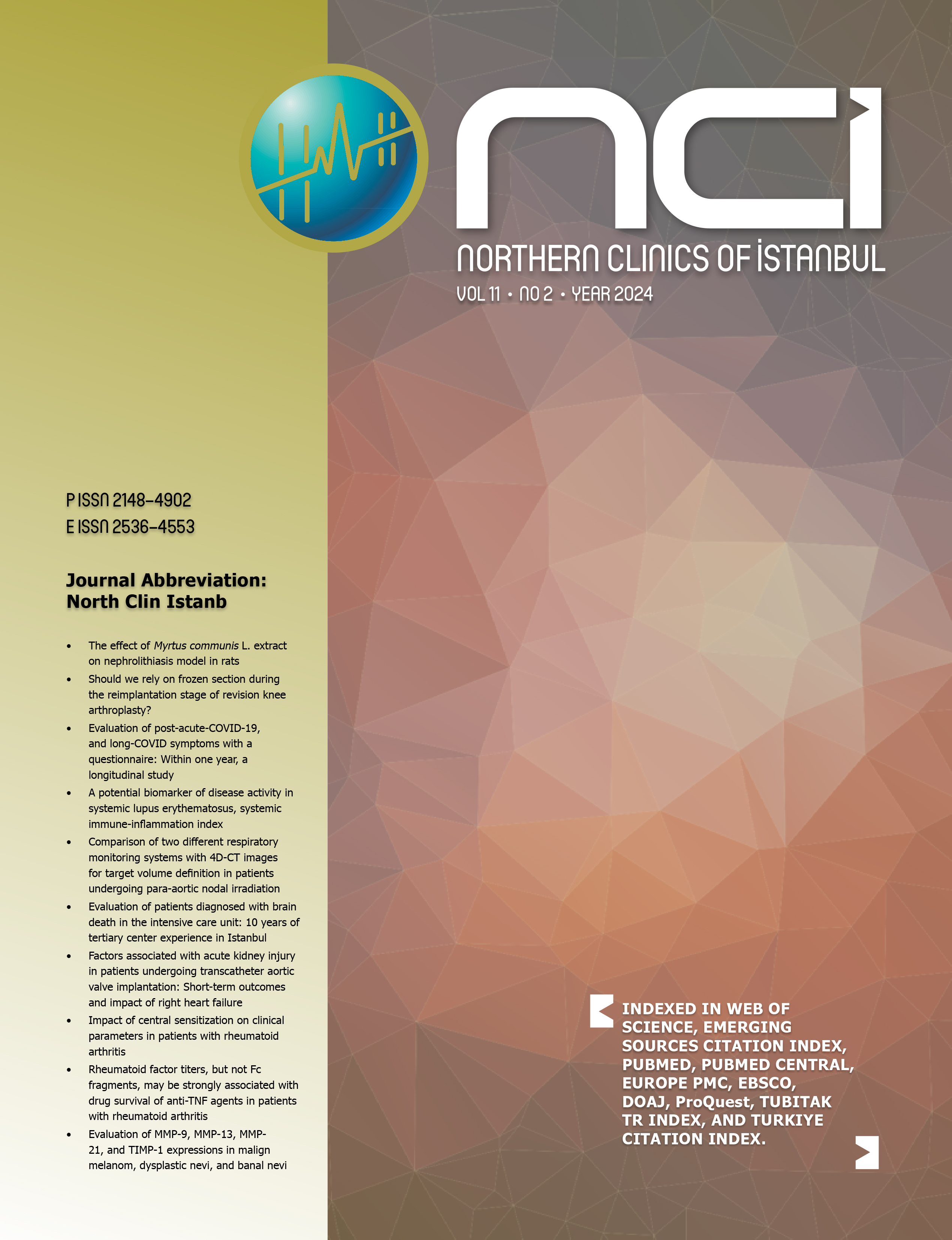Evaluation of area and volume changes in the costoclavicular region in patients treated nonoperatively after mid-shaft clavicle fracture
Kadir Gulnahar1, Muhammet Okkan2, Neslihan Buyukmurat3, Emre Karadeniz41Department of Orthopedics and Traumatology, Tuzla State Hospital, Istanbul, Turkiye2Division of Hand Surgery, Department of Orthopedics and Traumatology, Mersin University Faculty of Medicine, Mersin, Turkiye
3Drug and Medical Device Department, Istanbul Provincial Health Directorate, Istanbul, Turkiye
4Department of Orthopedics and Traumatology, Kocaeli University Faculty of Medicine, Kocaeli, Turkiye
Objective: The aim of this study is to radiologically compare area and volume changes in the costoclavicular region with the unaffected side in patients treated nonoperatively after unilateral midshaft clavicle fracture and to evaluate functional outcomes.
Methods: This study included 16 patients (14 males, 2 females) with midshaft clavicle fractures who were admitted between 2017-2018 and union was achieved with conservative methods. Magnetic resonance imaging (MRI) of the shoulder including the costoclavicular region was performed after union. Area and volume calculations of the fractured and unaffected costoclavicular region of the patients were performed on the standard MR sections under the guidance of a specialist radiologist. The Short Version of Disabilities of the Arm, Shoulder and Hand (QDASH) score was used for functional assessment. Range of motion was measured on the affected and unaffected sides at the last follow-up visit.
Results: The mean age of the patients was 30.4 ± 20.8 years (5-69) and the mean follow-up was 8.3 ± 1.3 (6-10) months. The mean shortening was 14.3 mm ± 8.2 (3-29). The area measurements of the costoclavicular region were divided into 3 levels in axillary section: acromioclavicular joint, mid 1/3 of the clavicle, and sternoclavicular joint level. The median area measurements were 1115 (364-3675) mm2, 1495 (365-4199) mm2, and 1201 (197-3812) mm2 on the unaffected side and 895.5 (351-3670) mm2, 1098.5 (340-3191) mm2, and 1037.5 (166-3237) mm2 on the fractured side, respectively (p=0.905, p=0.491, p=0.888). In volume measurements, the median volumes of the unaffected side and the fractured side were 34.3 (10.7-69.7) mm3 and 28.9 (8.1-60.9) mm3, respectively (p=0.268). No significant difference was found in the statistical analysis of area and volume measurements. At the end of the follow-up period, the QDASH score and functional outcome of the patients were good.
Conclusion: Conservative treatment of midshaft clavicle fractures did not result in significant area and volume changes in the costoclavicular region. The inability to clinically demonstrate the theoretical expectation of decreased area and volume on the fractured site suggests that other biomechanical factors are involved in the healing process of the human body.(NCI-2024-3-13)
Keywords: Clavicle fracture; conservative treatment; costoclavicular region.
Klavı̇kula orta şaft kırığı sonrası amelı̇yatsız tedavı̇ edı̇len hastalarda kostoklavı̇kular bölgedekı̇ alan ve hacı̇m değı̇şı̇klı̇klerı̇nı̇n değerlendı̇rı̇lmesı̇
Kadir Gulnahar1, Muhammet Okkan2, Neslihan Buyukmurat3, Emre Karadeniz41Tuzla Devlet Hastanesi, Ortopedi ve Travmatoloji Kliniği, İstanbul2Mersin Üniversitesi Tıp Fakültesi, Ortopedi ve Travmatoloji Anabilim Dalı, El Cerrahisi Bilim Dalı, Mersin
3İstanbul İl Sağlık Müdürlüğü, İlaç ve Tıbbi Cihaz Hizmetleri Başkanlığı, İstanbul
4Kocaeli Üniversitesi Tıp Fakültesi, Ortopedi ve Travmatoloji Anabilim Dalı, Kocaeli
Amaç: Bu çalışmanın amacı tek taraflı midshaft klavikula kırığı sonrası nonoperatif tedavi edilen hastalarda kostoklavikular bölgedeki alan ve hacim değişikliklerini etkilenmemiş taraf ile radyolojik olarak karşılaştırmak ve fonksiyonel sonuçları değerlendirmektir.
Yöntemler: Bu çalışmaya 2017-2018 yılları arasında başvuran ve konservatif yöntemlerle kaynama sağlanan midshaft klavikula kırığı olan 16 hasta (14 erkek, 2 kadın) dahil edildi. Kaynama sonrası kostoklaviküler bölgeyi de içeren omuz manyetik rezonans görüntülemesi (MRG) yapıldı. Hastaların kırık olan ve olmayan kostoklaviküler bölgelerinin alan ve hacim hesaplamaları uzman bir radyolog rehberliğinde standart MR kesitlerinde yapıldı. Fonksiyonel değerlendirme için Kol, Omuz ve El Engelleri Kısa Versiyonu (QDASH) skoru kullanıldı. Son takip ziyaretinde etkilenen ve etkilenmeyen taraflarda hareket açıklığı ölçüldü.
Bulgular: Hastaların ortalama yaşı 30.4 ± 20.8 yıl (5-69) ve ortalama takip süresi 8.3 ± 1.3 (6-10) aydı. Ortalama kısalma 14.3 mm ± 8.2 (3-29) idi. Kostoklaviküler bölgenin alan ölçümleri aksiller kesitte 3 seviyeye ayrıldı: akromiyoklaviküler eklem, klavikulanın orta 1/3'ü ve sternoklaviküler eklem seviyesi. Ortanca alan ölçümleri etkilenmemiş tarafta sırasıyla 1115 (364-3675) mm2, 1495 (365-4199) mm2 ve 1201 (197-3812) mm2 ve kırık tarafta 895.5 (351-3670) mm2, 1098.5 (340-3191) mm2 ve 1037.5 (166-3237) mm2 idi (p=0.905, p=0.491, p=0.888). Hacim ölçümlerinde, etkilenmemiş tarafın ve kırık tarafın medyan hacimleri sırasıyla 34.3 (10.7-69.7) mm3 ve 28.9 (8.1-60.9) mm3 idi (p=0.268). Alan ve hacim ölçümlerinin istatistiksel analizinde anlamlı bir fark bulunmadı. Takip süresinin sonunda hastaların QDASH skoru ve fonksiyonel sonuçları iyiydi.
Sonuç: Midshaft klavikula kırıklarının konservatif tedavisi kostoklaviküler bölgede anlamlı alan ve hacim değişikliklerine neden olmamıştır. Kırık bölgesinde teorik olarak beklenen alan ve hacim azalmasının klinik olarak gösterilememesi, insan vücudunun iyileşme sürecine başka biyomekanik faktörlerin dahil olduğunu düşündürmektedir. (NCI-2024-3-13)
Anahtar Kelimeler: Klavikula kırığı; konservatif tedavi; kostoklavikular bölge.
Manuscript Language: English





















